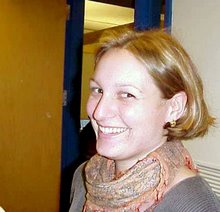
Those of you who read this blog regularly will remember that we made a trip out to the countryside last weekend but, due to time and technical constraints, I haven’t been able to post pictures of the adventure until now. These photos were taken on a visit to a friend-of-a-friend in what Mongolians call the “far countryside”. In other words, the barren landscape that you see here accurately conveys the remoteness of this family’s lifestyle.
To set the scene: It was really, really cold last weekend. In fact, it started snowing on our Friday trip from Ulaanbaatar to Erdenet (via Amarbaysagalant Khiid, see post entitled
Chasing Camels in the Snow for more) and when we awoke on Saturday morning in Erdenet there was snow on the ground. Unfortunately seven people died in the eastern part of Mongolia due to the unseasonably (i.e., early) cold weather (reaching about -15 degrees Celsius). Meanwhile, we were hearing from family and friends in Buffalo that the weather was reaching into the 80s Fahrenheit. Sigh.
Anyway, despite the snowy and icy conditions we set off for a destination somewhere in Bulgan Province. The family we visited is nomadic, often moving their
ger several times a year in order to provide the best pasture for their animals and to secure a close and clean water source (usually the Orkhon River). I have always been amazed by Mongolian drivers’ uncanny sense of direction. The “roads” one follows on trips such as these are really nothing more than extremely bumpy dirt tracks. Although forks in the road don’t appear constantly, they occur with enough regularity to make me glad the navigation responsibilities are never mine.
We arrived at our destination in the early afternoon, and were immediately escorted inside the
ger. Our hosts immediately offered us bowls of
airag (the Mongolian national drink, made from fermented mare’s milk) and snacks of
aaruul, a dried milk product that can be made with or without sugar. After many rounds of drinking
airag (it’s very mildly alcoholic, but I think it would take massive amounts to make anyone tipsy), and eating
aaruul and a kind of cream called
tsotsgii, we went outside into the bitter cold to watch the children of the family milk the mares. They jokingly offered to let me do the milking, but it’s a rather difficult task, as they first allow the young foals to nurse for a few moments, then move the foal aside (still keeping it close to its mother) and reach down to milk. The 16 year-old girl in charge of milking had hands that were as quick as lightening. She also was walking around in a sweater and a pair of jeans, while I was freezing in my long underwear, Gore-Tex jacket, hat and gloves. So much for being a hardy Buffalonian- talk to a Mongolian nomad if you want to know the definition of
hardy.
 Aaruul
Aaruul is pictured above (this
aaruul is drying in the family's ger)-- I chose this picture because I thought all you crafters out there might be interested in seeing the hand-embroidered decorations adorning the walls of the home.


After the milking was done, we went back into the
ger while the men stayed outside and prepared the meat for our meal. Typically this would involve slaughtering a sheep or goat, but as we’d brought some goat meat with us, the process was shortened a bit. Women are not involved in the slaughtering process, and, in fact, are strongly discouraged from watching, so I wouldn’t be able to tell you much about it anyway. Our meal was
horhog, a kind of pressurized meat and vegetables dish that is one of my favorite Mongolian meals. You usually use a large container that looks like it would be used to hold milk but we cooked ours over the fire in the ger. First you gather small rocks (about the size of a fist) and put them directly in the fire to heat them. Meanwhile, you prepare the meat and vegetables (in this case, potatoes, carrots and cabbage). When the rocks are burning hot, you remove them from the fire and put them in the cooking vessel. Then you add water, meat, vegetables and salt, and then more rocks. You put the lid on the vessel (and, in this case, since we weren’t using the typical pressure cooker container, we sealed the lid with rags to simulate a pressure cooker) and after 45 minutes to an hour, you very slowly and carefully remove the lid. The rocks that are used to cook the meat are distributed to everyone. You quickly move the rock from your right to left hand (again and again), the idea being that the heat from these rocks improves circulation and is otherwise likely to bring health benefits. Voila! A tasty goat meat lunch, with potential healing properties to boot!
After eating, we rode horses, and I taught an impromptu English lesson to the girls of the family at the request of their father. (They now know how to sing “Head, Shoulders, Knees and Toes” in English.) The Mongolian horses are known for having short legs—John looks like a real giant in the saddle!


I’m also posting a short video clip of a calf carcass being eaten by vultures on the way to Amarbaysagalant Khiid. It gives a good idea of what a dirt road is like here, as well as the real remoteness of the countryside.


















































